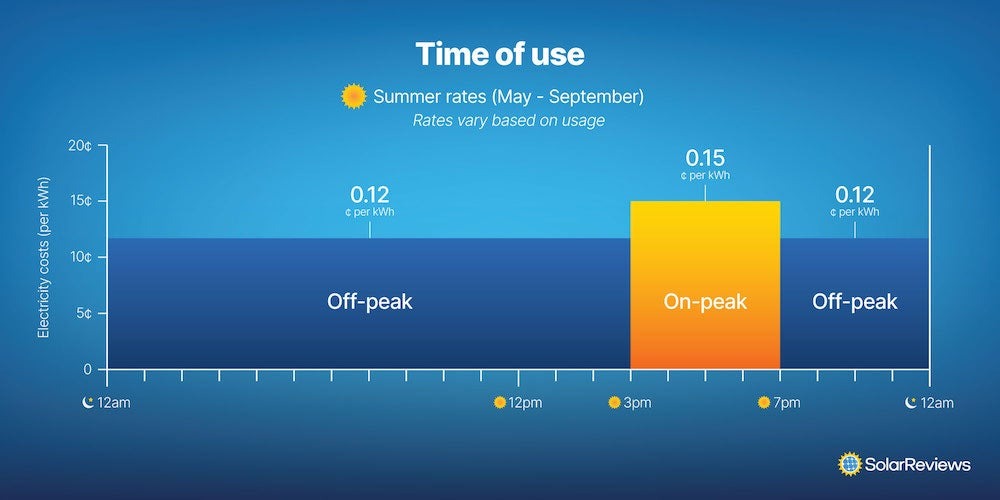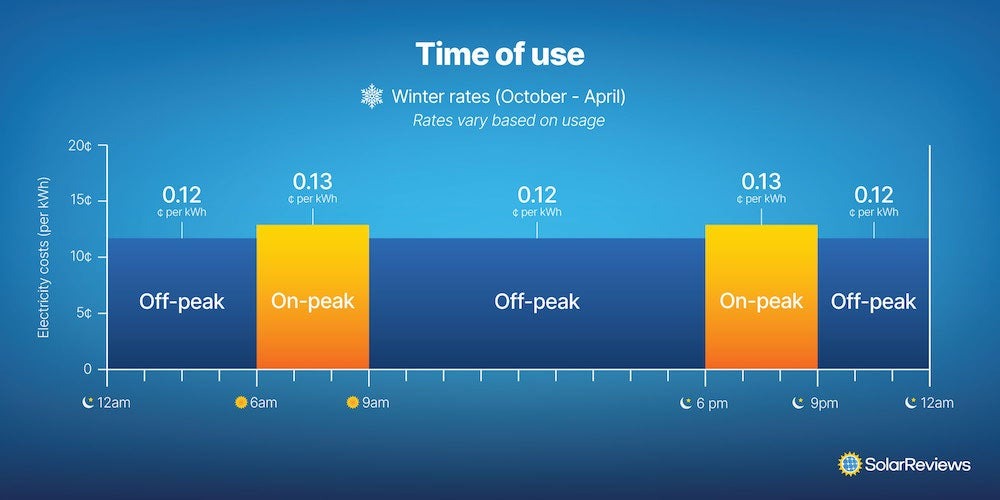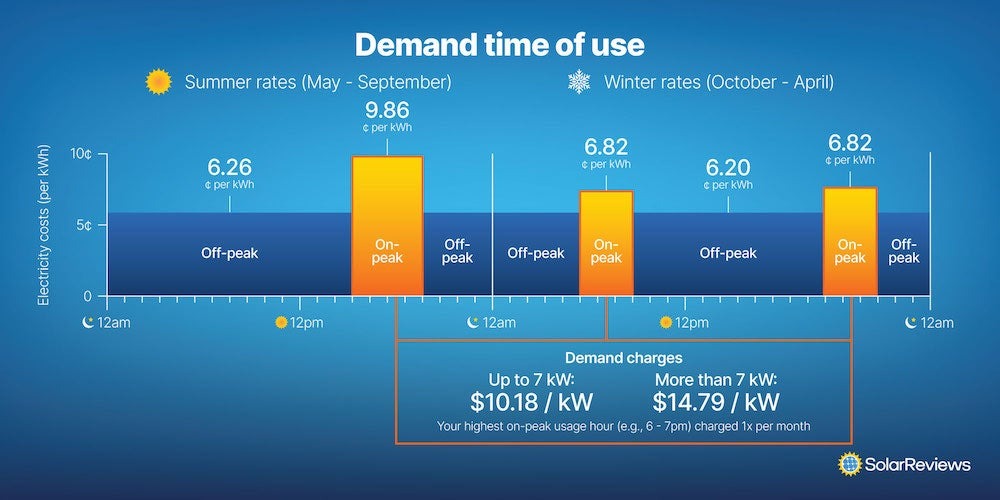Updated 5 months ago
Homeowner’s guide to going solar with Tucson Electric Power (TEP)
Written by
Catherine Lane

How much can solar panels save you on your TEP bill?
If you live in Arizona, chances are, you’re used to the constant sun and heat. Why not use all that sunlight to your advantage?
Buying solar panels in Arizona can save homeowners thousands of dollars over their 25-year lifespan, but the utility company you have could impact just how much savings you’ll see with solar.
We’ve put together a guide of everything residents need to know about going solar with Tucson Electric Power Company (TEP), including whether or not solar is a worthwhile investment with this particular electric utility.
Key takeaways
-
To cover a monthly TEP electric bill of $150, you would need to install a solar system that costs about $18,530, after incentives.
-
TEP does not offer net metering, however, their current solar buyback rate of $0.0570 per kWh can still provide great savings.
-
TEP requires solar customers to use Time of Use rates, which lowers solar savings a bit.
-
It takes between 2 to 4 weeks to get a solar system up and running with TEP.
How much does a solar system cost in Tucson?
Most homeowners in TEP’s service territory will pay somewhere around $2.60 per watt of solar installed.
To completely cover a $150 electric bill in this area, homeowners would need a 10.73 kilowatt (kW) solar system, which would cost about $27,900 before any incentives are applied. After you take the 26% federal solar tax credit and Arizona’s state solar tax credit into account, the system would cost just $18,530.
The following table outlines the estimated installation costs for different solar system sizes in TEP’s service territory:
Monthly electric bill | System size | System cost before incentives | System cost after incentives* |
|---|---|---|---|
$100 | 6.66 kW | $17,316 | $11,121 |
$150 | 10.73 kW | $27,900 | $18,530 |
$200 | 14.43 kW | $37,520 | $25,264 |
*Includes 30% federal solar tax credit and Arizona state tax credit
Keep in mind, these numbers are just estimates. The actual solar system size you need and how much it will cost depends on a handful of factors, like the location of your home, direction of your roof, and the installer you choose.
Does TEP offer net metering?
No, TEP does not offer net metering to their solar customers. Instead, they offer a net billing program. They sound similar, but there is a key difference - net billing provides lower solar savings than net metering.
You see, when your solar panel system generates more electricity than your home uses, that extra electricity has to go somewhere. In most cases, it gets sent to the grid, and when a utility offers net metering, the solar homeowner will get paid at the full-retail rate of electricity for that excess solar electricity. So, if the utility charges $0.10 per kilowatt-hour (kWh) for electricity, they’ll pay you $0.10 per kWh.
With net billing, the utility does not pay you at the full-retail price of electricity for your solar energy. Instead, they will pay you at a lower rate. TEP calls this the Resource Comparison Proxy rate, or RCP rate, and it’s valued at $0.0570 per kWh of excess solar electricity sent to the grid. This is about 47% of TEP's average electricity rate, making your solar savings lower than if the company offered net metering.
You are paid the same RCP rate for 10 years. After 10 years, your excess solar will be worth whatever the excess purchase rate is in effect at that time.
Should you install a solar battery with TEP?
If you’ve been looking into solar, you might have seen some things about how solar batteries can save you money if your utility doesn’t have net metering. This is true, you could save a little bit more on your bills with energy storage since TEP doesn’t have full-retail net metering.
But, solar batteries have a pretty significant upfront cost - upwards of $10,000, in fact. The extra $0.03 to $0.05 you save per kWh of electricity by using your battery instead of the grid won’t make up for the price of the battery, especially because TEP’s buyback rate is still pretty close to the retail rate of electricity.
So, if your goal is to save the most money possible, you probably don’t need a battery right now. With that said, having the peace of mind of knowing that you have access to backup power in case of a grid outage, could make the price worth it.
Learn more: Net metering vs. solar batteries: which makes more financial sense?
What TEP rate plans can I use when I install solar?
TEP solar customers are required to use one of their Time of Use rate plans. With Time of Use rates, TEP charges you more when electric demand is high and less when electric demand is low. There are two Time of Use plans available for TEP customers: a basic Time of Use plan and Demand Time of Use plan.
TEP’s Time of Use rate plan
Despite the name, TEP’s basic Time of Use rate plan isn't really basic at all. The price you’ll pay for electricity depends on three things:
The time of day you use it;
The time of year you use it; and
How much electricity you have used
TEP splits their day into “on-peak” and “off-peak” hours. On-peak hours are usually times of day when there is the most stress on the grid. So, in order to incentivize homeowners to use less electricity during these times, they make the electricity prices higher. During off-peak hours, electricity is cheapest.
Now let’s get into how the season and your usage impacts what you pay for electricity.
Summer Time of Use rates

Electricity rates are highest during the summer months, especially during on-peak hours, which are from 3 PM to 7 PM on weekdays. All other hours of the day and weekends are considered off-peak.
The on-peak prices for electricity are about $0.15 per kWh, depending on how much electricity you use. If you use less than 500 kWh of electricity in a month, you’ll get a lower rate, and if you use more than 1,000 kWh, you’ll have to pay a higher rate. Off-peak rates are about $0.12 per kWh.
Winter Time of Use rates

The Winter Time of Use rates work just like the summer rates, just with lower rates and different on-peak hours. From October to April, you’ll be charged the highest rates from 6 AM to 9 AM and 6 PM to 9 PM on weekdays. All other hours of the day and weekends are off-peak hours.
Depending on your usage, you’ll pay about $0.12 per kWh during on-peak hours. During off-peak hours, you’ll pay between $0.11 per kWh. The lower your total monthly electricity usage, the lower the rate you have to pay.
Depending on your usage, you’ll pay between $0.11 per kWh and $0.13 per kWh during on-peak hours. During off-peak hours, you’ll pay between $0.10 per kWh and $0.12 per kWh. The lower your total monthly electricity usage, the lower the rate you have to pay.
TEP’s Demand Time of Use rate plan
Solar homeowners can also use TEP’s Demand Time of Use rate plan. Like the basic plan, TEP charges more or less for electricity, depending on the time of year and time of day.
There are two major differences between the Demand Time of Use plan and basic Time of Use plan:
The energy charges are lower for the Demand Time of Use plan, ranging from $0.06 per kWh to around $0.10 per kWh, depending on the season and time of day
There is an additional monthly Demand Charge

So, the price you pay for electricity will still depend on whether you’re using it during on-peak or off-peak hours, but the rates are lower than with the regular Time of Use rates. However, those lower rates come at a price - you have to pay a Demand Charge for how much stress you put on the grid during peak hours.
The monthly Demand Charge is based on your highest hourly energy usage from the grid during on-peak hours, measured in kW. So if your maximum energy demand is less than 7 kW, you will be charged $10.18 per kW of demand. If your maximum energy demand is higher than 7 kW, you will be charged $14.79 per kW of demand.
Say your fridge and stove are running at the same time during on-peak hours and require 4 kW of energy to run, your monthly Demand Charge would be:
4 kW * $10.18 per kW = Demand Charge
Demand Charge = $40.72
And that’s on top of what you pay for your electric usage!
Which TEP Time of Use plan is best for homeowners with solar?
Most solar homeowners are going to be better off using the basic Time of Use plan because it will provide the highest solar savings. The Demand Charges in the Demand Time of Use plan will automatically make your electric bill higher even though the electricity rates are lower. Plus, Demand Charges can’t be offset by net billing credits!
Does TEP offer any solar incentives or rebates?
No, TEP does not offer solar incentives or rebates. They do offer some energy efficiency rebates that can help homeowners save on things like smart thermostats and EnergyStar appliances, which you can read more about here.
The good news is the state of Arizona has a tax credit equal to 25% of system costs up to $1,000. Most solar systems will get the full $1,000.
What’s great is that the Arizona state tax credit can be used on top of the federal solar tax credit, which is equal to 30% of solar installation costs until 2032. That means Arizona homeowners who have TEP will be able to receive thousands of dollars in solar tax credits - not bad!
Does TEP have a community solar program?
Yes, TEP does offer two community solar programs for their customers who can’t install solar on their roofs. In fact, when you go to TEP’s website and try to find information about going solar, these are the programs they promote the most.
Community solar programs are usually popular among renters or homeowners who don’t have roofs that are suitable for a solar installation. Let’s take a closer look at the ones offered by TEP.
TEP GoSolarShares
TEP GoSolar Shares lets you purchase “shares” of solar generation from a large-scale solar facility owned by TEP. Each share is equal to 150 kWh of solar energy and costs $1.50. Let’s look at an example:
Say you use 750 kWh of electricity in a month and you wanted all of your electricity to come from solar, you would need to purchase five GoSolar Shares, which would add $7.50 to your existing electric bill.
This means if you’re looking to save money on your electricity bill, the GoSolar Shares program isn’t for you. But, if you can’t install solar and you're concerned about your carbon footprint, then maybe look into the program. You can read about it more here.
TEP GoSolar Home
Unlike GoSolar Shares, TEP’s GoSolar Home program can actually provide you with some electric bill savings. Under the GoSolar Home program, you can get your electricity from one of TEP’s solar facilities for a fixed energy rate for 10 years.
Here’s how it works: you apply for the program and TEP determines how much your fixed monthly payment will be, based on how much electricity you used last year. You’ll then pay that amount every month for the next 10 years, so long as your energy usage stays pretty much the same. If your annual usage goes up or down by more than 15%, TEP will give you a new rate.
At first, the price of your GoSolar Home bill will probably be in the ballpark of your regular electric bill. So how does this save you money? Usually, utility prices increase every year, leading you to pay more for the electricity you use. But with GoSolar Home, you’re locked in to the same fixed payment, meaning you won't be experiencing price increases for 10 years, which saves you money in the long run.
You can learn more about exactly how TEP’s GoSolar Home program works on their website.
Should you participate in a community solar program instead of installing solar on your roof?
We think the TEP GoSolar Home program is a great option for renters or people who can’t get solar up on their roof, as it still provides long-term electric bill savings while increasing access to renewable energy.
But, if you can install solar on your own home, you should. Why? Because even though you have to take care of the upfront costs of a solar installation, you’ll end up saving more on your electricity bills if you own your own solar panel system than you would with the GoSolar Home Program. Plus, solar panels add value to your home, so if you wind up selling your house at any point, you can get more money for it.
Steps to going solar with TEP
The main thing you need to worry about when going solar with TEP is finding a solar installer that you trust to complete the job. The installer will handle the majority of the paperwork and communication with the utility.
The entire process, from when you submit your solar application to getting your system operating, will take between two and four weeks. The exact timing can vary depending on the project, and steps include:
1. Document submittal
Once you’ve chosen your installer and they’ve designed a system for you, they’ll draw up the paperwork to send to TEP. This paper work includes an application, a site plan, wiring diagram, and an interconnection agreement.
2. TEP application and interconnection review
Within seven days of receiving paperwork from your installer, TEP will review your application to make sure nothing is missing. Within 14 days, TEP will complete their interconnection review. TEP will send an email to both you and the installer to inform you if your application has been approved.
3. Installation
Once approved, your installer can pick up TEP-supplied metering equipment necessary to complete the project. From there, your installer is able to get on your roof and start installing! The installation will take between one and three days, depending on the system design and how complicated it is.
4. Submit Notice of Installation Complete
Once the installation is finished, your installer will submit a Notice of Installation Complete (NIC) with TEP. This signals to TEP that your system is complete and ready for inspection and meter installation.
5. Meter set/exchange
When TEP receives the NIC from your installer, they will schedule a meter set to install a solar production meter at your home.
If there are any issues detected during the meter set, your installer will be notified. Issues must be remedied within 30 days or you may have to resubmit your application.
6. Permission to operate
After your solar production meter has been installed, your system is ready to be turned on! TEP will send you written confirmation that your system has permission to operate, and then you get to start saving with the sun.
Is going solar with TEP worth it?
Once you take everything we talked about into account, yes, it is worth it to go solar with TEP.
Right now, TEP’s solar buyback rate is still pretty good, even though it’s not the full-retail rate. Because of this, homeowners can still get solid solar savings and see a good return on their investment. Not only that, Arizona offers a solar tax credit for homeowners that reduces upfront costs for solar installations.
But remember, the rate at which TEP purchases solar energy isn’t going to stay the same forever. Next October, the rate will likely be lower than what it is now. This means if you want the highest solar savings possible, consider going solar sooner rather than later.
The easiest way to start your solar journey is with our solar panel calculator. You can get an estimate of how much you can save on your TEP bills with solar, and when you’re ready, we can help get you in touch with reliable, local solar installers.
Catherine has been researching and reporting on the solar industry for five years and is the Written Content Manager at SolarReviews. She leads a dynamic team in producing informative and engaging content on residential solar to help homeowners make informed decisions about investing in solar panels. Catherine’s expertise has garnered attention from leading industry publications, with her work being featured in Solar Today Magazine and Solar ...
Learn more about Catherine Lane